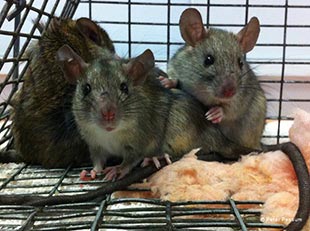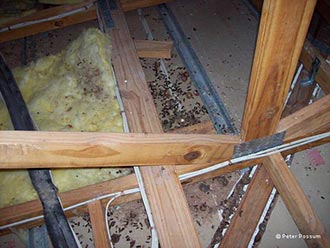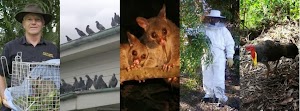1. ANIMAL DESCRIPTION
Common name: Black Rat (House Rat / Roof Rat)
Scientific name : Rattus rattus
SIZE
Adult size when fully grown is around 320 to 650mm long including the tail which can be 170 to 250mm for both the male and female of the species.
WEIGHT
Adult weight when fully grown is around 110 to 340 grams.
COAT
It has a short fur coat that can range from black, brown, grey, white and a mixture of each colour depending on lineage and breeding. So the colour of the coat is not a reliable way to distinguish it from its “cousin” the Norway or Brown rat scientifically identified as Rattus norvegicus.
FEATURES
The Black rat originated from Asia many thousands of years ago. It migrated to Europe as a passive traveller during the Roman times, when spices first started to be traded between Asia and Europe. The Black rat’s history in Australia is said to date back to the first European settlers when they arrived on the first fleet.

Black Rats Caught In a Roof
2. ECOLOGY
They eat a wide variety of food types (omnivore) and it will eagerly eat dog food, chicken food, fruit, seeds and greenery including leaves, stems and buds. It will also dine on small creatures including insects and bugs plus other less aggressive rodents and other mammals.
It certainly can out-compete our native small mammals and marsupial rats. They are also a scavenger and will happily live in garbage and sewers and eat human refuse from rubbish bins and any food scraps that humans discard. Each day they will consume around 15 grams of food and drink about 15 ml of fluids.
They have been identified as a serious threat to Australian natural habitats because they feed on native wildlife and compete aggressively with them for the available food. Farmers are also affected by Black rats as they are responsible for damage to valuable agricultural crops.
Like all rodents, it is very adaptable when it comes to living in a new environment. In Australia it can be found from coastal environments to high density urban areas. The Black rat has no problem surviving in the urban environment: in people’s homes, office spaces and industrial premises, as well as chicken pens, vegetable gardens, drains and sewers.
Rats are great climbers and can fit through very small openings and gaps to access areas for food and shelter. If a hole is big enough to fit its skull, about the size of a golf ball, then it will wriggle the rest of its body through if there is a safe place to hide or food to be eaten. So rodent control is essential because it is virtually impossible to keep them out of buildings and roof spaces.
it will make its home in small dry areas that are hidden from view and possible predators. It creates a nest from shredded materials that it scavenges then tears up to create a cosy home.
3. BEHAVIOUR
Rats Brisbane tend to forage after the sun has gone down, but this does not make them solely a nocturnal creature. The Black rat will try and eat from a wide range of foods as this allows it the choice of the best quality food available at a certain period of time and with a high breeding rate, this is the main reason it is such a successful survivor.
The variety of food also enables them to balance its diet and combine a healthy nutrient intake. This variety also reduces its intake of any one food and so can reduce the subsequent intoxication of the rats system by eating any one poisonous food source. This explains why professional specialists will often use several types of commerical baits.
They are in fact very clean animals and their nests and sleeping areas are usually free of droppings and mouldy food.

Black Rat Droppings
4. BREEDING
The breeding cycle of the black rat is a year round process. There is no apparent down time when they will not breed (except during famine when the female will delay the breeding cycle). The female will give birth to 5 to 8 babies up to 6 times per year. The young are usually weaned from the mother after 20 days from birth. Astoundingly the young female can commence breeding at only 68 days of age. From this equation a solitary female can produce around 60 babies per year. In a boom season when a plague is experienced, the birth rate and rapid breeding cycle explains the exponential growth in numbers and the need to get rid of rats even if numbers are low.
5. HOME OWNER RAT PROBLEMS
The Black rat can cause physical damage to a home and its contents plus spread unwanted diseases to the inhabitants. The rat can chew through walls, cupboards and other parts of a house to gain entry.
It has also been known for centuries for carrying devastating diseases such as the black plague which wiped out thousands of people in medieval times due to poor rodent control. Although the threat of the black plague is now virtually non-existent, rats do carry other diseases that are serious and sometimes fatal to human beings.
The droppings and urine when left in cupboards and home surfaces are an easy way for humans to be infected with the diseases rats carry. The risk of human salmonella food poisoning when they eat and forage through rubbish and then enter people’s homes and contaminate stored food, is massively increased.
An associated risk is leptospirosis spread by rats (also called Weil’s disease). Though recognized among the world’s most common diseases transmitted to people from animals, leptospirosis is nonetheless a relatively rare bacterial infection in humans. This infection is commonly transmitted to humans by allowing water that has been contaminated by animal urine to come in contact with unhealed breaks in the skin such as cuts and abrasions, human eyes, or with the mucous membranes of the nose. Outside of tropical areas, leptospirosis cases have a relatively distinct seasonality with most of them occurring in the spring and autumn. In the Brisbane area it has been noted as a minor risk to humans. Although it is not common it can have devastating effects on humans.
There is also a rat lungworm parasite that is a nematode, spread by slugs. It causes a type of meningitis. The nematode (Angiostrongylus cantonensis) lives in their arteries but it transfers to the slugs through rat droppings. In 2011 a 10 month old girl in north Sydney became lethargic and died and a post-mortem indentified the cause of death as a rat lungworm infection; it may have come from crawling over slug trails. In 2010 a 21 year old man became critically ill after eating a slug as a “dare”. So slugs and rat droppings should be avoided. If they must be touched then rubber gloves are advisable.
Without good rodent control, Black rats, will enter areas where humans store their food like pantries and cupboards and gnaw with their incisor teeth into food containers. In one evening the Black rat can damage hundreds of dollars’ worth of food by simply chewing through the packaging.
No health concerned home owner would attempt to eat the food that a rat has been found chewing on. The risk of disease, infection and illness is enough to justify throwing the damaged food away, replacing it and getting rid of rats.
6. SUMMARY – HOW CAN PETER THE POSSUM MAN HELP YOU?
Rodent control requires specialised knowledge and must be carefully combined with any other pest control needs you have. In particular, you must consider that possums could eat rodent baits and die, so any baits that might be accessed by other animals, including pets and children MUST be placed in lockable secure plastic bait boxes. These are specially designed for the purpose. Our servicemen will always inspect the roof and ensure no possums can get in before we lay rat baits in a roof cavity.
The benefit for you is getting access to the stronger professional baits, the specialist knowledge based on experience and access to good advice about your particular circumstances for the best control of rats on your property. Getting rid of rats Brisbane successfully is a professional pest controller’s task.
So call Peter the Possum Man and ask for your local specialist Brisbane rodent controller. Our staff are highly trained pest controllers who will get rid of your unwanted guests promptly and efficiently. Our company has over 25 years experience dealing with furred and feathered pests and know many of the techniques to control rats in Brisbane today.







